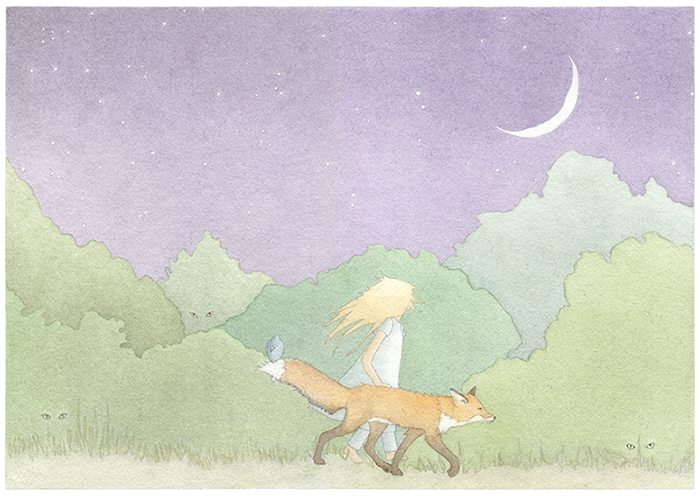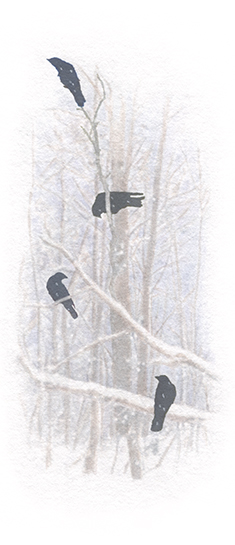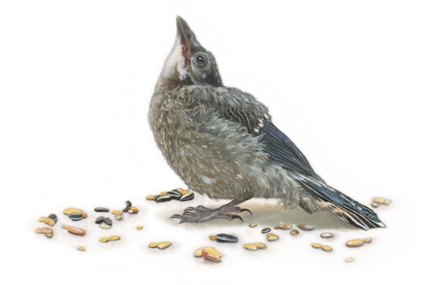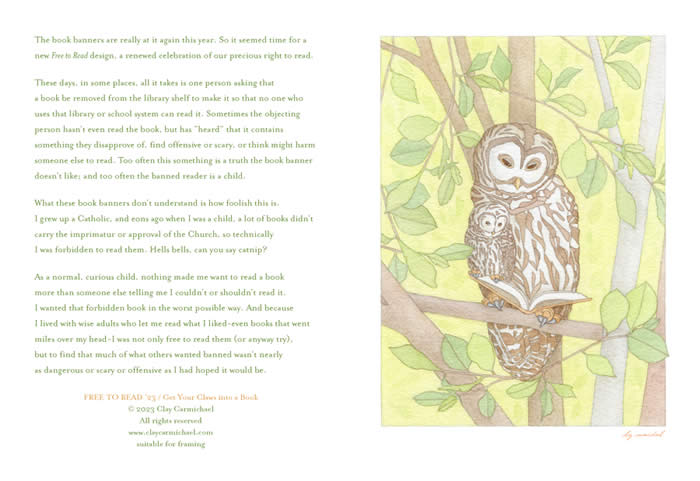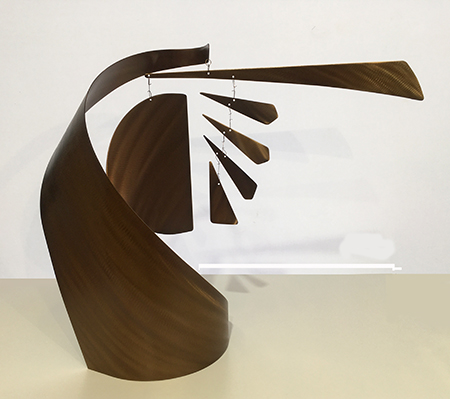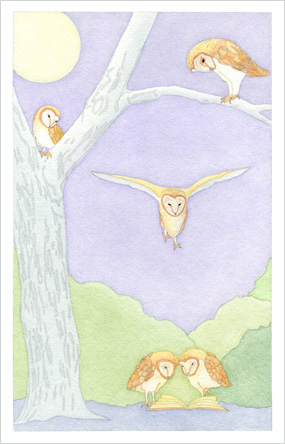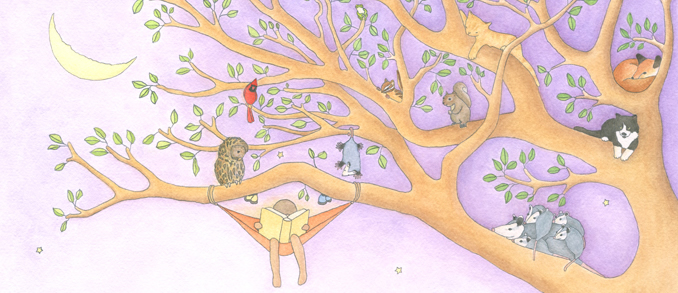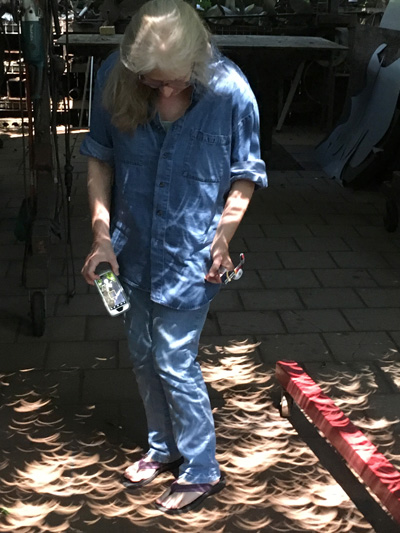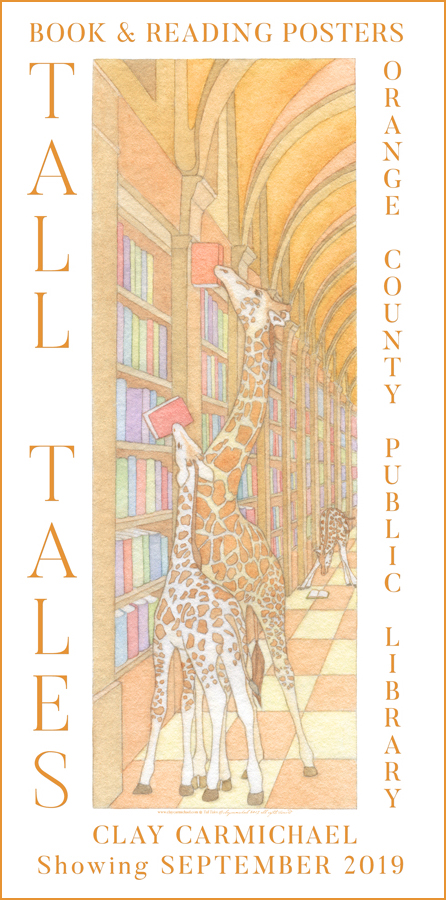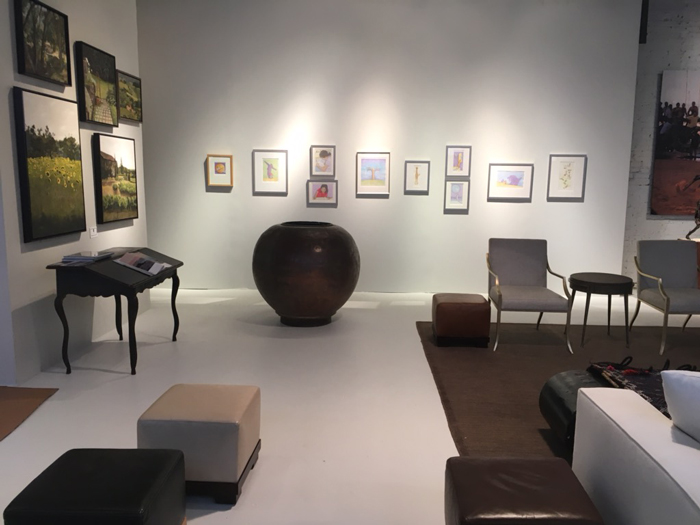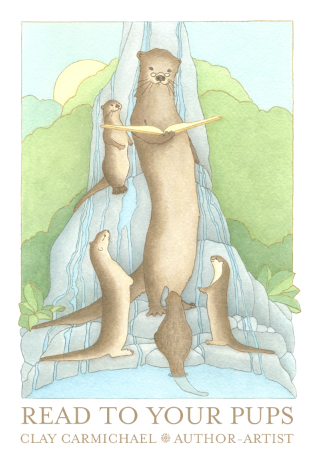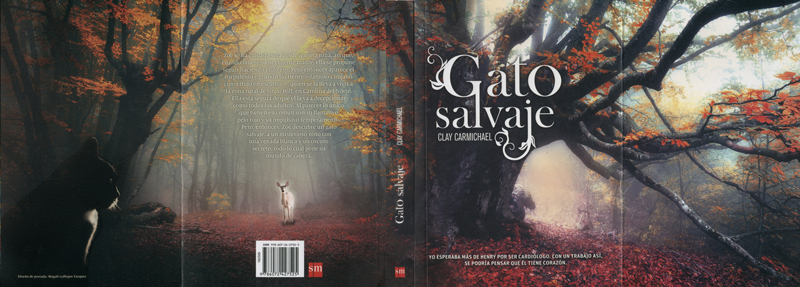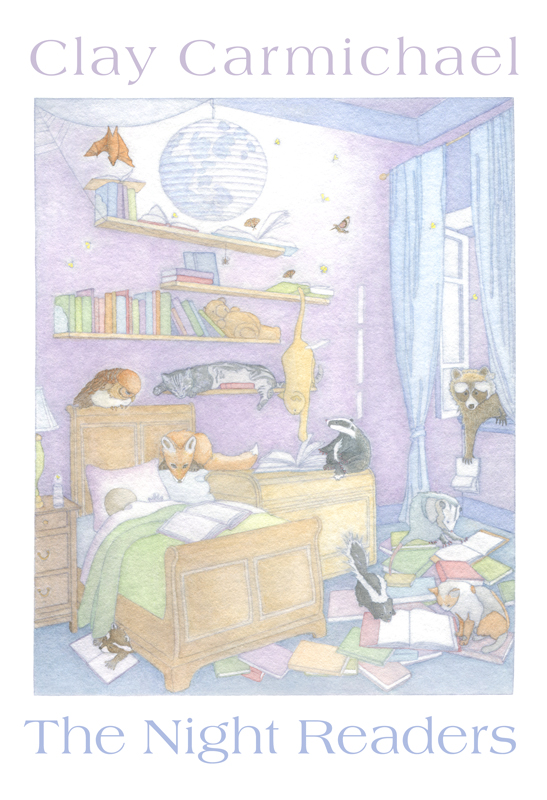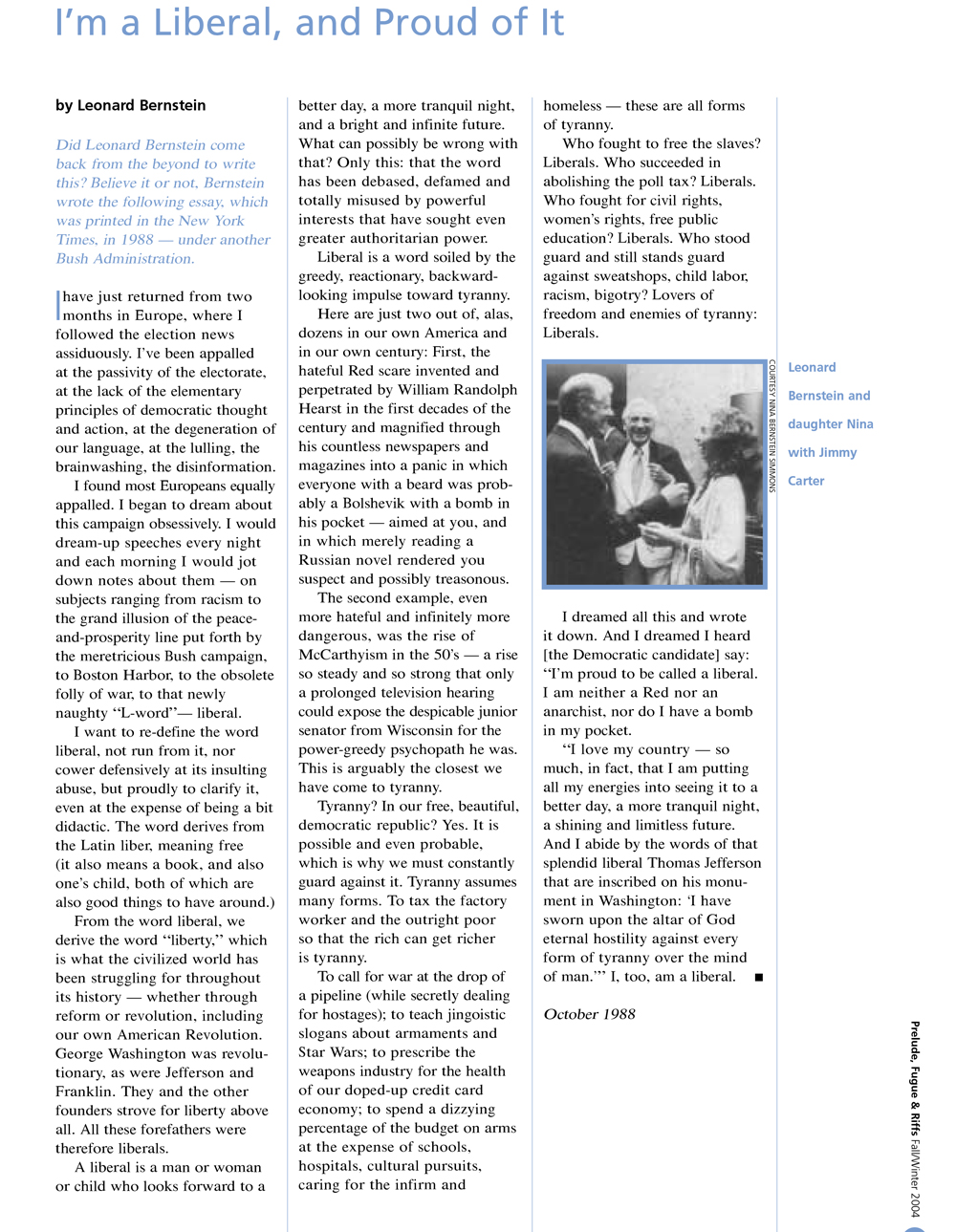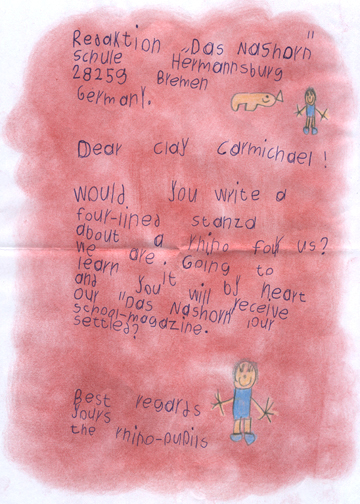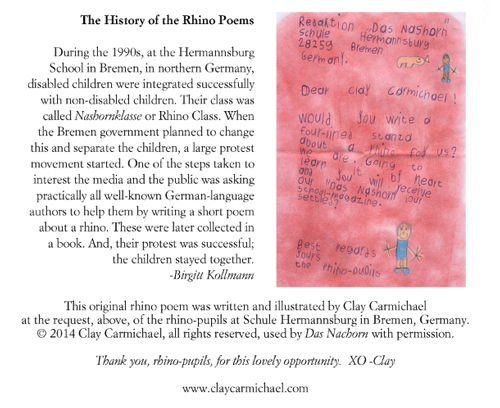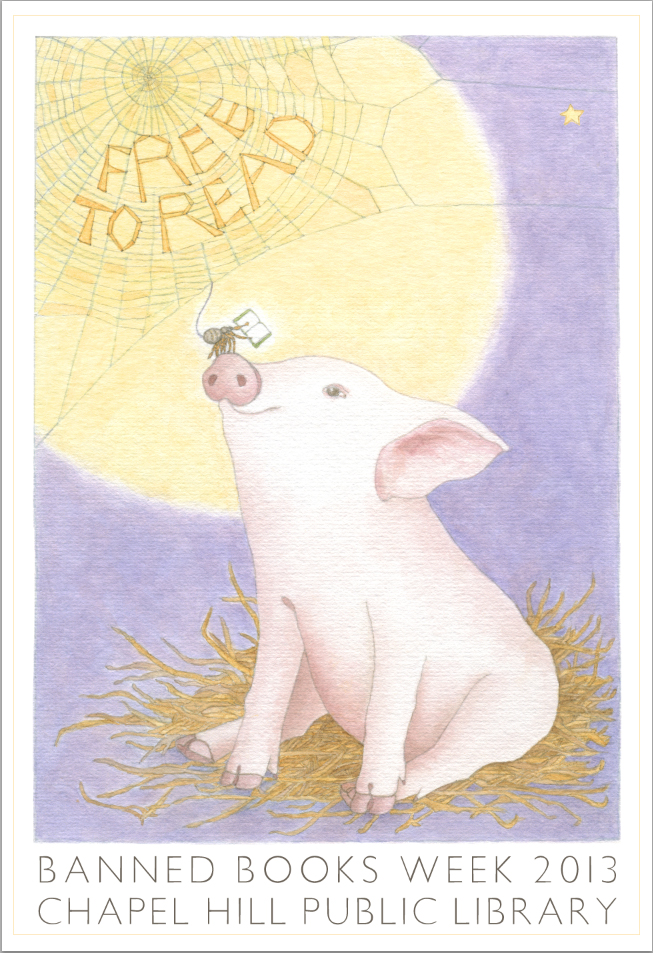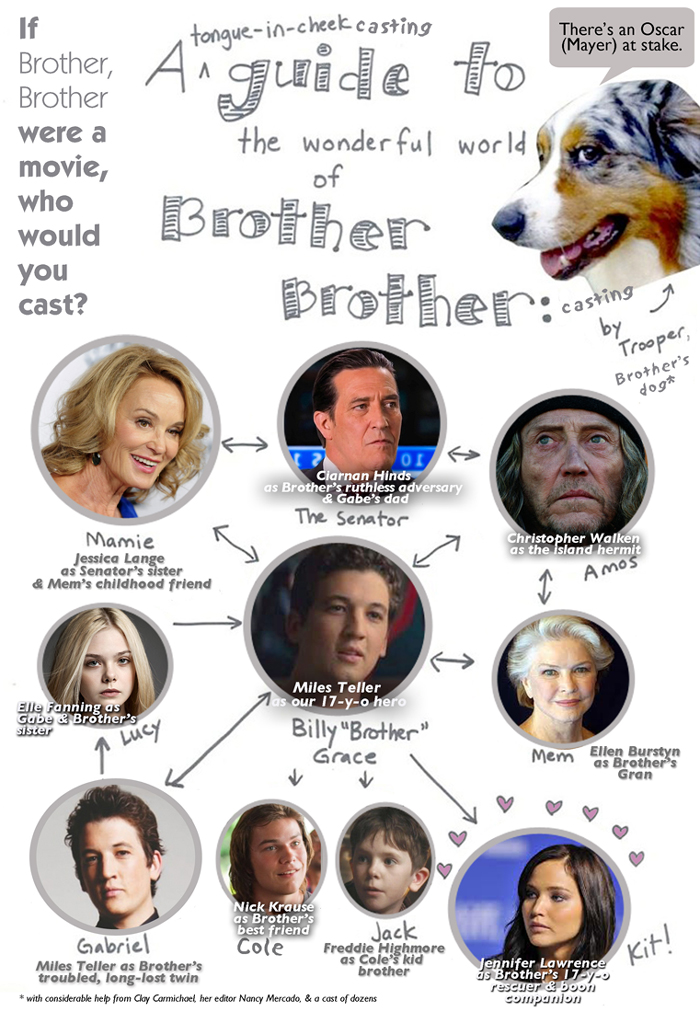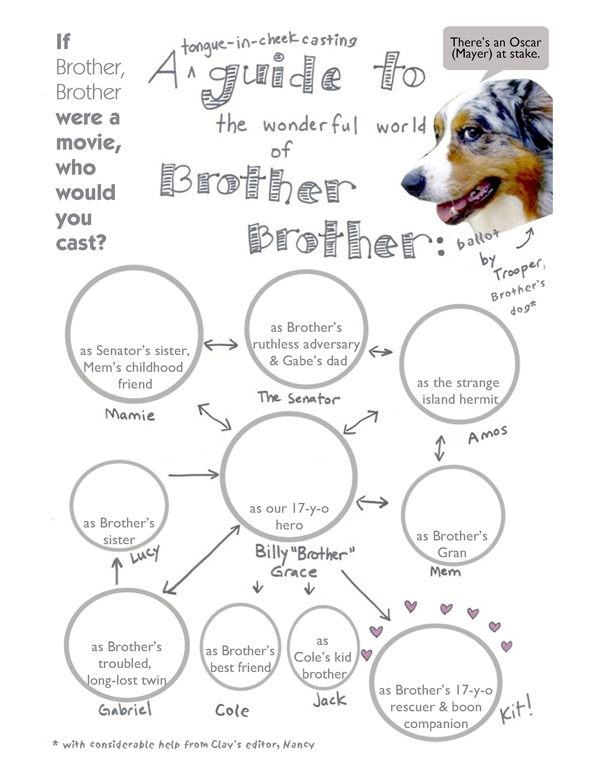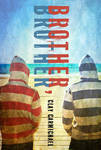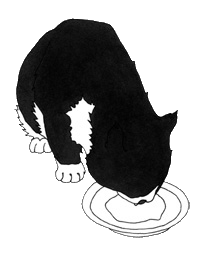![]()
 |
|||
Muses Are Everywhere ~an occasional blog~
|
|||
|
The Night Watch, NEW, full giclée print image
Snow Crows--Izzy continues to fly in every morning for nuts to cache. Following are a deer family,one of whom eats out of our hands. Not far behind are four fish crows pictured in my newest card with a little story on the back: The Kindness of Crows Every morning we put out peanuts for Happy New Year, all.
New Card for 2023 --Izzy, Such Riches, Here's the essay on the back of the new card. True Story!
A little head with a big open mouth popped up ‘like a jack-in-the-box’--as husband Mike
New Free to Read Card for 2023 --The Book Banners Are Really at It Again Essay
The book banners are really at it again this year. So it seemed time for a These days, in some places, all it takes is one person asking that What these book banners don’t understand is how foolish this is. As a normal, curious child, nothing made me want to read a book
--Clay Carmichael 2023 / Get Your Claws into a Book / Free to Read 2023 Card
Well, when I called this an occasional, I seem to have meant it. The 2022 Orange County Artists Guild Open Studio Tour is upon us. Last year's tour was hugely busy, a blur. Think people wanted to get out of their houses, and did they ever .We're having another open air tour in Mike's studio this year. Mike, after building one of three big commissions he has at present, scaled back with some riffs on Calder he calls Soirées with Sandy. I'll link his photos when he gets around to updating his site, alledgedly tomorrow. But here's one:
Soirée with Sandy #1 /stainless steel/ Mike Roig; Owl Light / watercolor, ink, pencil /Clay Carmichael If you want to see the first completed commission, you'll have to come by, as it's still offically under wraps until the others are nearer completion. Saturday and Sunday this Nov 5-6 and 12 -13. 10-5 Sat and 12-5 Sun. Masks still a good idea, we think, we'll have them on. Oh, and just to keep up with announcements, the film/TV option has been recently renewed for Wild Things and right after tour Clay's Cards will be available at the North Carolina Botanical Garden Shop.
Post: September 20, 2020 Find information about the 2020 Orange County Artists Guild VIRTUAL Studio Tour HERE. Updated 10/19/20: Purchase, Pick-Up and Shipping info for Clay's Cards and Prints During the Pandemic Above, Bedtime Story (detail) card / Print here Several wonderful local galleries and shops that sell my prints and cards have reopened with limited hours and I hope you'll mask up and visit them to see my work up close and personal, The Hillsborough Arts Council Gift Shop (F-Sat, 12-4) and North Carolina Crafts Gallery (T-Sat 10-6). In-person visits to my small studio must wait until things are safer. That said, a number of folks have asked me if there's a safe way they might buy custom orders of my cards and prints directly from my studio as they did Before. So I've worked out a safe pandemic plan to fill local and shipped orders. Please go to my catalog here: http://claycarmichael.com/ClaysCardsCatalog.htm More print info here: http://www.claycarmichael.com/ARTCARDSARCHIVALPRINTS.htm Decide what you'd like (Most of my card and print images are pictured there and card images are available as prints.) Then email me your order at claycarmichael@gmail.com Cello-wrapped cards are $4, plus tax in-state. Wrapped, unmatted, archival prints are $25, small; $50, large, plus tax in-state. Local Orders: I'll fill and wrap your order and leave it on our Carrboro front porch for you to pick-up at a specified time (in case of rain). You'll receive an invoice from me by email through Square, with NC sales tax applied, and you pay this invoice online with your credit card. A friend did this recently and said it was, as my character Zoë says, easy-peasy. Sorry, no drop-bys or deliveries. Cards by mail/shipped $4 each + actual shipping and sales tax if in-state. Prints by mail/shipped are $25, small; and $50 large, plus actual shipping and sales tax if in-state. Invoice thru Square as above. Thanks so much for your continued interest in my work. Please stay safe. Clay
Above, True Blue card *****
Clay during the Eclipse with the moons at her feet
|
|||
|
Tall Tales is up at the Orange County Public Library. A baker's dozen of my book and reading posters and my Alpha Beta alphabet will show there for the month of September. The giraffe-librarians were painted especially for the show. Many thanks to the librarians and staff for the invitation and assistance and to Betty Schumacher for suggesting and championing this wonderful idea.
Post March, 2019 The show's up at JK Gallery in High Point, NC, and it looks great. I'll be showing there April through June. All much-loved originals this time--no prints--a rarity for me.
Post February, 2019 Scheduled this week: This September 2019, I'll be exhibiting a collection of my reading posters at the Orange County Public Library in Hillsborough, NC.
.....
Post January, 2019 New Year Catch Up/The Amazing Panoramic Cover of Wild Things Spanish Edition
.....
|
|||
Post November, 2018 Open Studio Tour 2018/Shows 2019 Each year I create one or two reading posters, and here's The Night Readers for 2018's Open Studio Tour.
.....
|
|||
Post December, 2017
I signed a contract this year with Quarto, a publisher in California, to bring the three Bear books together in one volume and back into print. I spent three months rescanning, digitizing and color correcting the original art, and I now have copies of the bind-up for all those who've waited so patiently since the three books have gone out of print. Bear is back! .....
Post November 9, 2016 I turn to this essay for light, hope and solace whenever I feel my country has taken a seriously wrong turn, as it has many times in some of the darkest, and, as now, authoritarian moments in our history. It was written by one of our greatest artists in 1988, long before 911 and our subsequent rush to senseless war based upon the lie of weapons of mass destruction. I posted it in my studio then, and post it here now because it seems so current, but mostly to console myself, uplift me, and to make me remember what I love best about my country and give me hope for the future. I pray my country remembers its better self soon.
Posted for Education purposes. Link here, page 3: http://www.leonardbernstein.com/pfr/pfr_FALL04RE2.pdf .....
Letter from Germany on the eve of the 2016 Election We had open studios over the weekend, very successful on two beautiful days. So lovely to see and visit with all the young and older fans of our work, to have lots of our art go out into the world. And still. And yet. There was a pervasive sense of anxiety in those who came, a worry mostly unspoken now, or only briefly alluded to, as everyone's so weary of talking about what seems to thoughtful people so obvious. This letter came just before we opened our doors from my German translator, become dear friend, Birgitt Kollmann. Reading it, it's hard not to think the obvious: Germans in particular know too well what is at stake here; what hardheartedness, despite tomorrow's election outcomes, is churning here, now. As I texted Birgitt: I write and paint and work to keep the faith. Dearest Clay, dear Mike,
Tonight I was lying awake for hours, basically owing to a bad flu, but more and more it was the thoughts circling in my head that kept me awake. Denk ich an Deutschland in der Nacht, dann bin ich um den Schlaf gebracht, our 19th century poet Heinrich Heine once wrote. (Thinking of Germany at night /Just puts all thought of sleep to flight.)
But though far from all is perfect in Germany, right now it’s more the U.S. that keeps us worried and fills us with alarm and foreboding. I do wonder whether a large number of Americans are aware of how people all over the world, and probably most of all in Europe, are focussing on the U.S. elections these days, and have actually been doing so for weeks and months.
And it’s not just some game we are watching from the tribunes, some championship. It just feels terrible to know that not only the future and fate of your country is at stake but also the whole world’s. Very many people, not just me and our family and friends, also people with otherwise greatly diverging political views dread the thought of waking up next Wednesday morning to a world in which that grandson of a German émigré barber whom Germany unfortunately didn’t allow back in at the time, has been made the most powerful man around.
It is not that over here we’re all great fans of Hillary Clinton’s; it would have been good to have a younger generation shouldering responsibility for the future, but if in a nation of over 300 million no one else can be found but these two candidates, then Mrs. Clinton certainly is the more reliable, balanced, and trustworthy candidate.
I do know, dear Clay and Mike, that I don’t have to convince you. I just felt like putting this down on paper, and perhaps you can let Open Studios visitors know how very much dependent we are on their vote.
I’m glad you’re busy these days, otherwise you’d probably turn crazy with worries. Have a lovely, successful weekend, in spite of all.
Love,
Birgitt ..... Post April 13, 2016: North Carolina Children's Book Authors and Bookstores for Repeal of HB2
Download a pdf of this letter ..... Post March 16 2015: Wild Things is named to the 2015-2016 NCSLMA Battle of the Books list! http://www.ncslma.org/msbob Pleased and honored to be in such company.
..... Boy, do I have a lot of Google translating to do. But what delightful pictures and poems so far and what company I'm in these pages, wow and zounds! Just a few of my fascinating offbeat, wildly talented and far-flung fellow rhino poets and translators: Macedonian poet Lidija Dimkovska, Cameroonian writer Patrice Nganang, Hans Christian Anderson Award recipient Jutta Bauer, Julia Donaldson, 2011-2013 British Children's Laureate and MBE; Lebanese writer Jabbour Douaihy, German Jazz Master Eberhard Weber, Algerian author Yasmina Khadra, and three particular favorites: Slovene writer Boris Pahor "internationally most notable for his Holocaust experience described in the novel Necropolis" and who, as notably if you ask me, is 101 years old; Harry Rowohlt, "German writer and translator who also plays the role of a derelict in the famous German weekly soap Lindenstrasse"; and Marianne Koch, retired German actress "best known for her appearances in spaghetti westerns," most famously mit Clint Eastwood in Fur eine Handvoll Dollar. Smaller world, how delighted I was to find Miriam Pressler whose excellent YA Let Sleeping Dogs Lie was published by my Wild Things publisher, Front Street. While I brush up on my languages, I leave you with the rhino stylings of National Book Award winning and Ruth Lilly Prize Poet Gerald Stern: I love rhinos because they're not winos; most drunks are skunks.
Post February 10 2014: The Rhino Pupils or Another Chapter in the Exotic Life of the Author Ten days ago, the marvelous but mysterious letter below arrived from Germany via Macmillan, one of my publishers. Would I write a four-line stanza about a rhino for the rhino-pupils in Breman, Germany?
Also enclosed were two photocopies of rhino-stanzas written in much earlier years by authors Paula Fox and Doris Lessing, presumably so I would understand that the writing of rhino poems was a distinguished tradition. "We are going to learn it by heart," they wrote of my as yet unwritten stanza, "and you will receive our Das Nashorn, our school magazine. Settled?" And that was all. Naturally, I scanned and emailed the letter to my German translator and good friend Birgitt Kollmann. Did she know anything about this rhino-poem tradition? Indeed she did, and soon replied: "...the background was this: At this school in Bremen, in northern Germany, disabled children were integrated successfully with non-disabled children. Their class was called "Nashornklasse". (Rhino Class) When the Senate (= gov't) of Bremen planned to change this and separate the children, a large protest movement started. One of the steps taken to interest the media and the general public was asking practically all well-known German-language authors for a poem. These were later collected in a book. And their protest was successful, the children stayed together." Apparently this tradition continued and stanzas were and continue to be solicited from authors outside Germany. Lucky me. I had the gist of my verse in my head within an hour and set to work to illustrate it, the time-consuming part, designing it as a four-panel fold-out card. I'd never drawn and painted a rhino before. What fun! This morning I mailed the Bremen rhino-pupils my illustrated rhino stanza:
Settled! .....
Post December 6, 2013: Let's Chat on Twitter! 12/6/13: #Litchat on Twitter with @ClayCarmichael, author of BROTHER, BROTHER on Fri 12/6 4-5 pm/EST! Preview here: http://litchat.com/2013/12/05/guest-host-clay-carmichael/ .....
Post: Banned Book Week 2013, September 22-28: This year, I'm honored that one of my illustrations has been selected to be a Banned Book Week Trading Card at Chapel Hill Public, my hometown library, and that the image was recently chosen Best 2013 Banned Book Week Trading Card in a national vote. My thanks to CHPL, @my library, and to the American Library Association. I've also made the image into signed, limited edition archival 13 x 19 posters, all proceeds to benefit the library. Below, preview my illustration inspired by E.B. White's Charlotte's Web--13th on the American Library Association's list of frequently banned and challenged classics--along with my artist's statement. Posters are for sale at the library and I'll also have them available during Open Studio Tour in November.
Clay Carmichael / Artist's Statement / Banned Book Week 2013 If you can ban Charlotte's Web, you can ban anything. E. B. White’s Newbery-Honor-Award-winning Charlotte’s Web was first published in 1952, so it surprised me that the book ranks thirteenth on the American Library Associations’ list of Frequently Challenged Classics and that the challenges to the book occurred in the last ten years. This moving story about the friendship between Wilbur the piglet and Charlotte, a barn spider, was challenged in England in 2003 by a headteacher who was “aware of an occasion where young Muslim children in a class were read stories about pigs. This could have caused offence to religious sensitivities.” The Three Little Pigs and Winnie-the-Pooh were challenged, too, and removed from classes on the same grounds. The Muslim Council of Britain intervened, saying, “there are parents and families who believe that portraying the pig in books is wrong. But there is absolutely no scriptural authority for this view,” and asked that the titles be returned to the shelves. More recently, in 2006, parents in a Kansas school district challenged Charlotte’s Web, arguing that talking animals were blasphemous. “[H]umans are the highest level of God’s creation and are the only creatures that can communicate vocally. Showing lower life forms with human abilities is sacrilegious and disrespectful to God.” They argued, too, that Charlotte’s natural death at the end of the story was “inappropriate subject matter for a children’s book.” I’ve shown Charlotte reading to Wilbur, as friends do, after writing something appropriate to a book where both writing and reading save her good friend’s life. Truly, she was a spider ahead of her time writing on the web. As the author tells us as the end of the story: “It is not often that someone comes along who is a true friend and a good writer. Charlotte was both."
Trivia question: What book beat Charlotte’s Web for the Newbery Medal? Answer: click here. .....
Allied-Post, August 17, 2013 A few weeks ago blogger Marshal Zeringue asked me to pretend-cast my new YA Brother, Brother as a film. LOTS of you helped and what fun it was! Well, now the results are in. May I have the envelope, please? See the full post on one or both of Marshal's wonderful sites: Campaign for the American Reader or My Book, The Movie. Also check out his four-footed blog Coffee with a Canine. Arf!/Enjoy!
.....
Post: July 30, 2013 BROTHER, BROTHER debut week burning question! Who would I cast in the movie of my book? Blogger Marshal Zeringue of "My Book: The Movie" wants to know. Please send me your brilliant castings, oh readers, and to make this easier for you I've linked a fun nomination for download below. Hat tip, my wonderful editor, Nancy Elizabeth. Share all you want. Email casting suggestions here
..... Post: July 3, 2013 John Bemis, NC Piedmont Laureate, interviewed me this week for his Laureate blog. Thanks, John! JB: What made you decide to be a children's book writer? Clay: I didn't set out to write and illustrate for children. I did want to be a writer and loved art from an early age. As kids, my sister and I made regular visits to the Ackland Art Museum, though at first, I admit, we were more drawn to the dead guy in the tomb than the art....Read the rest here: http://piedmontlaureate.com/2013laureateblog.php .....
Post: March 6, 2013: A Short Meditation on Place/ 2013 AWP Conference Remarks Winter storm Saturn (what's with these names?) will keep me from driving north to Boston for the AWP conference this week. I wish my fellow presenters Zu Vincent, Debby Edwardson, and Kelly Bennett well and post my own brief pre-panel comments here:
“Write what you know,” Howard Nemerov said. “That should leave you with a lot of free time.” Said James Baldwin, “When you’re writing you’re trying to find out something which you don’t know.” And this longer quote from Jim Harrison: “What I hate about this notion of regionalism in literature is that there’s no such thing as regional literature. There might be literature with a pronounced regional flavor, but it’s either literature on aesthetic grounds or it’s not literature. In the view of those on the Eastern Seaboard, everything that is not amorphous, anything that has any peculiarities of geography, is considered regional fiction, whereas if it’s from New York, it’s evidently supposed to be mainstream. [Y]ears ago … it struck me that the Upper East Side of New York was constitutionally the most provincial place I’d ever been.” That I agree with all three of these writers should tell you that I’m more a write-what-you-don’t-know kind of writer and a universalist whose neighborhood happens to be North Carolina. Truth to tell, the term world-builder is a bit academic and high-sounding for me. As a realistic writer, the components of my fictional worlds are already out there fully formed. So what might be more accurate in my case is to say that I’m a writer-illustrator who uses my eyes and ears and all the craft I can muster to render my made-up characters and fictional worlds as best and truly as I can. Both my novel Wild Things and my upcoming novel Brother, Brother are carefully and intentionally set on North Carolina ground, a rich, diverse, much blood-watered and manure-augmented earth. I’ve lived there most of my life, a kind of immersion. And so the steeped tea of North Carolina landscapes, people, diversity, tongues, politics, and weathers permeates my stories.
…
Post: February 22, 2013: My Most Amazing Author Letter Ever / Why Author Visits Matter
"The writing life has incomparable advantages: flexible hours, mental challenge, the wardrobe—you can go to work in bunny slippers if you want to…And in time, if you’re truly blessed, you’ll begin to get mail. You’ll…tear it open, and find out everything you’ve ever done right in this world, and wrong. The mail will bring you more applause and brickbats and requests and advice and small, perfect bouquets than you can ever answer or even acknowledge. Its presence will cheer you on gloomy days, and guide you through the straits of your own conscience. It will stand as proof that you’re blessed." -- Barbara Kingsolver, High Tide in Tucson
Those who’ve heard me talk about my thoughtful, moving, wildly funny, often illustrated, glittered or candy-stuffed reader-mail know I get what BK means. Once in a great while, though, a real stunner arrives. The following amazing, miraculous, benediction of a letter came in yesterday’s early morning mail while I was still in my bunny slippers. I asked the writer if I might share it with my readers and colleagues. Thank you, Heather. Ms. Carmichael, I know you probably don't remember visiting a third grade class thirteen years ago, and you definitely don't remember me. However, I do remember you. I was either eight or nine at the time, a student of Mrs. Beckworth at Vena Wilburn Elementary. You came to visit us, telling us about your bear books. I'll admit that I can't really remember anything specific that you said about your writing and illustrating, but I do remember marveling over the pictures; I do remember going back to my classroom with the profound realization that someone actually made the books that I liked so much. I knew that I wanted to try and do the same thing, an affair that I actually set up that same day. I talked to a little boy in my class named Quinn, and the two of us decided that we would make a book, just like you - I would write the words, and he would illustrate. In reality, he only drew two of the pictures before growing bored with it, but I was determined. I wrote the whole thing and drew the rest of the pictures myself. Of course, not having yet grasped the concept of fiction versus non-fiction, the book was really more of a pamphlet with facts and scientific diagrams about flowers and pollination (the topic which we were at the time studying in science). Still, I bound the book together by tying some yarn through the holes in the notebook paper and proudly presented it to my teacher when I was finished. That was the first thing that I ever wrote. It was the second thing I composed that again brought me into contact with you. Encouraged by the perceived success of my first venture, during the next break from school I set myself to the task of typing my first real story. I wrote about a girl who wanted nothing more than to be a mermaid, so much so that she would wish upon a star and wake the next morning to find that it had come true. It was a rather typical story, the details of which evade my memory - something with a handsome prince, getting shot by an arrow, a kiss, and of course a happy ending. All of this was accompanied by illustrations that I painstakingly drew in Paint on my grandmother's computer and pasted into the Word document. I think it amounted to all of three pages, but this was quite a tome for a third grader. My child's mind teemed with exhilaration over the completed work, and I eagerly had my parents help me with emailing it to you, using the email that you had given us during your presentation in case we wanted to contact you. What happened next surprises me even now just as much as it did back then: I received a response. I suppose I will never know if it was you or one of your aides, but, in all honesty, that doesn't really matter. You read my story. I remember that you not only gave me praise, but you actually told me what I could do to get better, a sort of encouragement in a realm beyond praise. In fact, I remember exactly what you told me to do; you told me to slow down and to put more description into it. I devotedly rewrote the story - several times, actually - and composed many more of many varying lengths as I grew older. My name is Heather G., and I'm 22 now. In May, I'm going to graduate from my university summa cum laude with a Bachelor of Arts in English, and I intend to eventually get my Master's. I want to be a librarian. I've already been working in a library for almost four years where I get to interact with the most amazing people, exist at the forefront of every new publication, and share my passion with everyone else around me. I'm also working on writing a trilogy of my own that I want to have published one day. I know that all of this has little bearing on you, but I felt like I should share it with you in order for you to fully understand the weight behind the following sentiment. Today I was talking to my best friend about a local writer that is going to visit her daughter's school. It was during this discussion that I realized how much of my present I owe to your visit and your response email. That really inspired me and planted the seeds for the fruits that I now reap. If it were not for you, I do not know what I would be doing now. Though I already enjoyed reading, I doubt that I would have developed the passion for books and writing that I now have if you would not have come to talk to us. I wouldn't even have my best friend, as we met on a website for aspiring writers nine years ago. At the end of the day, I just wanted to let you know that you have made a difference in at least one person's life. More importantly, though, I wanted to say thank you. Sincerely,
Post: February 2013/A Foot in Two Worlds/Guest-poster on the Through the Tollbooth blog I have a new young adult novel, Brother, Brother (Roaring Brook) coming out this August and I’ve been working on final things with that manuscript, but also writing talks, visiting and Skyping with students—American and German—about my 2009 novel, Wild Things (Front Street/Boyds Mills Press), which is happily on three state award lists this year.
Both take place in North Carolina, but one is for younger readers and the other for teens; one has a cat, the other dogs; one an eleven-year-old girl, one twin teen boys. In Wild Things, the girl spitfire goes to live on the red clay of the North Carolina piedmont with her sculptor-uncle, while my other more passive main character in Brother, Brother seeks out his twin on the private island of a powerful, conservative U.S. senator. Going from one book’s world to the other is a bit whiplash inducing some days, not so much due to the different characters and places, but more because the emotional landscapes and character’s challenges so differ. It’s a bit of a psychic balancing act and requires a good emotional memory....Click here to read more on the Through the Tollbooth blog.
Post: November 2012 I've delivered my new young adult novel into the newly maternal hands of my editor Nancy Mercado and her assistant Angie Chen at Roaring Brook Press. Studio Tour and teaching are done for another year. Which means there's been a little time to check the back burner, view the beach footage husband Mike was kind enough to shoot during a birthday shore getaway, and carve out a one-minute book trailer for the book due out in August. See it here.
Post: November 15/Thanksgiving 2011 In April I received the request below, and with the help of Rhonda Purtee in the Boyds Mills Press order department and Harriet Linskey @ Hands Across the Sea (http://www.handsacrossthesea.net/), ten copies of 'Wild Things' headed to a book club in The West Indies. The photo below arrived with handmade thank you notes ("Thank you, because we really need them a lot") in yesterday's mail. Happy Dance.
…
Post: August 2011 Zoë, the German edition of my novel Wild Things, debuts this week and the early reception has been overwhelmingly generous, loving and kind. Birgitt’s first email to me came in summer 2010, out of the blue: Dear Clay, I thought I'd let you know that I've just started translating your wonderful book Wild Things into German and I'm very happy about it. If you like, we could keep in touch. My experience with other writers is that it is very helpful to talk about things in the process. Among the authors I have translated are Alison McGhee, Sarah Weeks, Susan Fletcher, Donna Jo Napoli, Joyce Carol Oates (her YA novels), Martine Leavitt, Laurie Halse Anderson, and I'm very happy to include you in my list. Looking forward to hearing from you, Birgitt My other books had been translated into various languages: Japanese, Chinese, Dutch, Spanish and one, Used-Up Bear into German, but no translator had ever contacted me, much less written to ask my help. I assumed translators, like most illustrators, were given manuscripts and worked without consulting the writer in order to develop their own vision of the work; in particular, to work out the music of the book in their own language and in the context of their own culture. Too, as someone who both writes and illustrates and who therefore has a strong vision for her work, I didn’t want to get in my translator’s way. I replied the same day: click here to continue reading
…
A few books I'm reading:
…
January, 2010 "I know the perfect child to give it to and now I cannot wait until Monday when I see her." ~In with the new! or On one occasion of being reminded why I do what I do~ Ten years ago about this time I was in New Jersey helping out my sister, whose business had just been featured on Oprah. There were just seven of us to handle the tidal wave of orders that followed. I handled the phones, or rather phone. The other elves were busy baking, making nosegays, packing the daily shipments—all high-end, perishable items. I talked on the phone and tracked packages, eighteen hours a day, give or take, for several stressful weeks. Don't get me wrong. The Oprah endorsement was a great thing, but the only way I can describe the onslaught after it is to say that the voice mail filled up every 30 minutes and I spent most of my time returning calls to tell disappointed, upset, or angry customers that our inventory was exhausted and new merchandise available only well after Christmas. The high-class campers were not happy. My low point came when I politely told one desperate, furious man that I was so sorry, but I didn't have even one pound cake left to sell him. Before slamming down his receiver, he told me he felt "betrayed." To counter such furies, I swam every morning at 5 a.m. at the local Y. You meet a hardworking, dedicated, salt-of-the-earth class of people in Ys at that hour, and that's where I met Loreli, a teacher in the local schools. We hit it off. I told her I was a children's author and illustrator and, as we dressed for work, we talked about daily life in the familiar way women do in locker rooms, and also about the many things we, who worked with and for children, had in common. I either gave her or sent her copies of my books for her classroom. I went back to North Carolina to start a new marriage and a new book, and Loreli and I lost touch. Fast forward ten years to this past Christmas Eve. On my way out the door to spend the holidays in Virginia, I got an email from Loreli. She's now a librarian, has been reading the Newbery buzz on my book, Wild Things and tells her aide: "I think I know her." She goes on, "I hate to admit it but sometimes I breeze by the reviews of YA books because my school only goes to 5th grade." I wrote her back during a few moments of solitude on Christmas Day. I was flattered she remembered me and glad to hear from her. I told her to please keep in touch and added that I thought some of her upper elementary kids might really enjoy Wild Things. Loreli wrote back to say she'd ordered a copy and looked forward to reading it. Yesterday I caught up on end-of-year business: emails, reviews, blogs, nominations and such concerning Wild Things. Among the mostly rave notices and few fair ones, I came across one really mean-spirited summer review, one I hadn't seen, by a librarian—now a former librarian, I'm happy to say. Many of my favorite people are librarians, and I can't imagine someone so unconstructively critical and harsh working with children. Oddly, her mean-spirited notice was one of two reviews which appeared in the same publication—the other was a rave review—but, of course, like the furious, "betrayed" customer of my sister's I still remember after all these years, it was the hateful review I couldn't get out of my head. Until today, on this eve of the new year—out with the old and in with the new—when the daily email brought this note from Loreli: Dear Clay,
Happy New Year to all, but especially to you, Loreli.
…
Thanksgiving 2009 Much to be grateful for this holiday—my favorite—& so I begin this occasional. A few things: Wild Things, my book about a resilient orphan, became an orphan itself last September, suffered Dickensian vicissitudes, but survived to thrive—though all the talented people who worked closely on the book remain laid off—publishers take note! My gratitude is vast for the good people who made Wild Things possible, the many rave reviews, beaucoup nominations, shortlists & the NC Juvenile Literature Award. Among this year's many high points was the invitation to speak at the North Carolina Literary Festival and I reprint my NCLF talk below to acknowledge, thank & celebrate the book's many muses. Thank you, thank you, all. -Clay |
|||
Do not neglect to show hospitality to strangers, for thereby some have entertained angels unawares. Hebrews 13:1-2
The first inspiration for my novel Wild Things walked into my life on all fours. I wish I could say that I took one look at that filthy, hungry, strikingly handsome creature and saw immediately the muse he was, knew instantly that he would steal my heart and transform my life. But ashamed as I am to admit it, I took one look at my four-footed muse and ran him right out of the yard. My muses have been non-standard from the start, when my father's Parkinson’s disease inspired me to write and illustrate my first picture book—and this was at a time when I not only didn’t illustrate, but hadn’t planned on writing children’s books at all. Maybe other writers are better at knowing a muse when they see one, but looking back now at mine, I see a lot of unlikely angels entertained unawares. That dreary winter morning, I didn’t see any angel. I glanced out my Carrboro kitchen window and saw, crouched in the periwinkle under the bird feeder, an enormous black-and-white tomcat. His head was huge, a build-up of scar tissue from years of fighting, but I didn’t know that then. He was black except for a white chest, stomach, four white paws and a rough triangle of white around his muzzle that rose to a point between two green-gold eyes. To the right of his pink nose was his most distinguishing feature: an oval splotch of black, as though someone had stuck a thumb into black paint then pressed a solid, sideways thumbprint just there. His “half mustache” was as unmistakable as a tattoo, and gave him a goofy look. Goofy, except that his eyes were fixed on several sparrows and two brown rats feasting on fallen seeds. Goofy, except that he was poised to strike.
When I was a child growing up in Chapel Hill, my grandmother—a muse for both the grandmother and the intolerant churchwomen in Wild Things—watched her birds, as she called them, every afternoon at the kitchen window while she prayed the rosary. Though she’d become a Catholic after marrying my grandfather, her faith retained the pragmatic, reactionary character of her depression-era, Southern Baptist upbringing. Her feeders and statues of St. Francis welcomed some animals, but not others. She beheaded snakes with a hoe, bombed moles and voles in their tunnels, and poisoned chipmunks, mice and rats. She despised squirrels and fought her gray nemesis with greased poles, worthless baffles, idiotic-looking wire contrivances and relentless, unsuccessful craft. But though she hated squirrels, the antichrist would have been more welcome than a cat. So whenever I remember my grandmother perched on her step stool in afternoon prayer, I remember the cap pistol she kept on the counter beside her, and how at the sight of a squirrel or cat she left-fisted the rosary, right-handed the pistol and flew out the door firing and screeching, “Scat!”
I grew up to disagree with my grandmother that there were good animals and bad animals, that the pretty and well-behaved ones should be fed and the ugly or troublesome ones beheaded, poisoned or gassed. Everyone ate at the birdfeeder behind my Carrboro house, even squirrels and the occasional mouse or rat. The mice and rats came from a neighbor’s compost pile and the next-door open field, which belonged to my friend Ruby King, another muse, who I made a friend of my eleven-year-old main character, Zoë, in Wild Things. But even though I fed all kinds of animals in my backyard, I did think it was wrong to entice creatures to a feeder so that other animals could hunt them there, so I shooed away the hawks, snakes and cats—including my own tabby—when I caught them hunting underneath. Which was why, on that winter morning, I did something that I shall regret all my days. I imitated my grandmother, flew out the front door, raced to the side of the house and chased off that frightened, funny-faced cat. At the time the cat came, I was learning to write and illustrate picture books for children. My then-husband, Sam, and I called our house the Love Bungalow, because whatever it lacked in comfort, it was full of that good feeling. It didn't have insulation or reliable plumbing. It barely had heat. A big kerosene furnace took up most of the living room, but only heated the house to fifty or sixty degrees. On cold days, we could see our breath in the two upstairs rooms and I wore gloves when I drew or typed. There were cracks in the outside walls we could see the front yard through. We filled them, but they opened up again as the house settled, and it was always settling. A crack an inch or two wide ran through the living room floor and foundation; we called it the San Carrboro Fault. When it rained hard, the downstairs flooded. That house was surely my muse for the drafty forest log cabin my main character Zoë finds and fixes up in Wild Things. The winter the cat appeared the weather was unusually raw. Ice storms bowed the trees, and the wind cut more sharply into anything warm-blooded, doubling the number of hungry birds at the feeder. Now and then, I caught glimpses of the cat again from my upstairs study window, but he was always gone before I could run through the bedroom, down the backstairs, across the kitchen and outside to shoo him away—so I stopped bothering and began to watch him. His stark coloring made him stand out, as did the heavy way he walked, more like a lumbering lion than a house cat, though his stubby legs could sprint when they had to.
He favored rats over poultry and unlike most cats, he never toyed with his prey before he killed it, which I admired. I remember vividly the day I understood that his hunting was a matter of life and death, that he was all alone in the world. I had just left my desk for lunch, and was walking by the bedroom window on the other side of the upstairs when I heard rustling in the leaves outside. I caught sight of him down below, hunched over something in the leaf litter. The area was overgrown with scraggly trees and privet; scattered with old tools, broken flowerpots, bricks and discarded clay pipe. He was tearing at something with his teeth and I saw he had killed a brown rat and was tearing off its fur in tufts to eat it, which he did, every edible bite. He ate quickly and ravenously, as the truly starving do. At first I felt sorry for the rat, then disgusted watching the cat eat it. But after a few minutes—which was all it took himto finish—I understood what I was really seeing: a lone, homeless, hungry animal surviving a hard winter as best he could. I realized he was wild.
These are the moments that I live for as an author. The moments in a character’s life where the heart shifts, where the eyes look and for the first time really see. That was the day my own heart shifted and I saw the cat’s life through his eyes. That was the day I began the first chapter of Wild Things, though it was years before I wrote a single word. In time, and it took a long time, that wild black-and-white cat came to trust me, and only me, the way the fictional cat in Wild Things comes to trust my main character Zoë, who has huge trust issues of her own. I, like Zoë, was patient, and, as in the book, one day that cat just decided about me. His cat heart shifted. He was sunning himself in the yard when I pulled into the drive. He was wary, as usual, as I got out of the car, but this time he didn’t bolt as I slowly approached him. Step by step I got closer, and closer still, and as I got to him he rolled over, showed me his belly and even let me scratch it. I have never felt so honored in my life. That was the beginning of our many years together and in those years we grew close. I called him Mr. C’mere, because "C’mere" was what he came to. During our time together, I wrote, illustrated and published three picture books. He made a cameo appearance in the third. He wasn’t ever tame. Until he was quite old, he went off for weeks at a time and came home as spent and bloody as a drunken sailor from doing what tomcats do best. His story and eventful life went on for ten more years, but it was the early years and our mutual shifts of heart that I tried to capture in Wild Things. Mr. C’mere and my first husband Sam died in the same year, within two months of each other. Mr. C’mere was very old, twenty the vet judged by his teeth. He died as peacefully as my husband did not. Loss is also a muse of Wild Things. The loss of love, of family, of home, of trust. At the beginning of Wild Things, the little girl Zoë has lost both her parents, along with any hope of a loving family, when her uncle Henry, a sculptor grieving the loss of his wife, takes her in. But Wild Things isn’t a tragic novel. In telling Zoë and the cat’s story, I wanted to write about what comes after the pain and the loss, about the restoration of trust. I wanted to write about human and animal resilience, those mutual shifts of heart; about the power of love to heal the heart and transform it. Which brings me to Wild Things’ other primary muse. One night, about three years after Sam and Mr. C’mere died, I was at a friends’ house admiring the beautiful stonework in their new outdoor pool, when I felt someone come up behind me, pick me up and dance me across the terrace. This someone was a sculptor, much like the sculptor I would later write about in Wild Things. He was someone I knew, though not well, but that changed pretty quickly. He and I were married six months later, and that was more than eight years ago. This muse I didn’t chase off, or have to work to win over. Sometimes muses take matters into their own hands. I don’t want to make too much of the “real life” in my book. My friend the storyteller Donna Washington says all her stories are true, except for the parts she makes up. I could name a dozen lesser muses. I could tell you, for instance, that the lifelike wooden animals the teen boy Wil carves in Wild Things were absolutely inspired by the beautiful wooden animal carvings of Carl Boettcher’s Circus Parade, a magnificent moving fixture of my childhood in Chapel Hill, first in the Circus Room of the old Monogram Club where we bought our ice cream cones when we were kids, then in the old Carolina Inn cafeteria where I ate hundreds of meals with my family, and last, now, in the UNC Alumni Center where I visit the Circus from time to time. But I also need to say that Wild Things is a work of fiction, a story I made up. Though my life and people and animals I know and have known inform the story, the situations and characters in it are really alive only in my imagination, and, I hope, in the pages of the book. In all creative work—at least all of mine—life and imagination converge. It’s my belief that all stories have happy endings depending on where you end them. I think I left Zoë and her cat in a promising place at the end of Wild Things. I live now very happily with my sculptor-husband in a beautiful sculpture-filled yard. Today, another mustachioed black-and-white cat from the shelter suns himself on the lawn. The house we live in, my muse Mrs. King’s former house, has heat and decent plumbing and stays warm and dry when it rains. But I can see the Love Bungalow, the drafty little house where I wrote my first book and met Mr. C’mere, from my studio window. And Mr. C’mere’s stone grave stands at the edge of the sculpture garden. Both are daily reminders, as Zoë observes in Wild Things, that things are beginning and ending, all in some measure, all the time—that muses are everywhere. Clay Carmichael September 12, 2009
|
|||
Some posts have reappeared in part @http://ocagnc.blogspot.com/ |
|||
Website ©2024 Clay Carmichael, All Rights Reserved. Permissions: claycarmichael@gmail.com |
